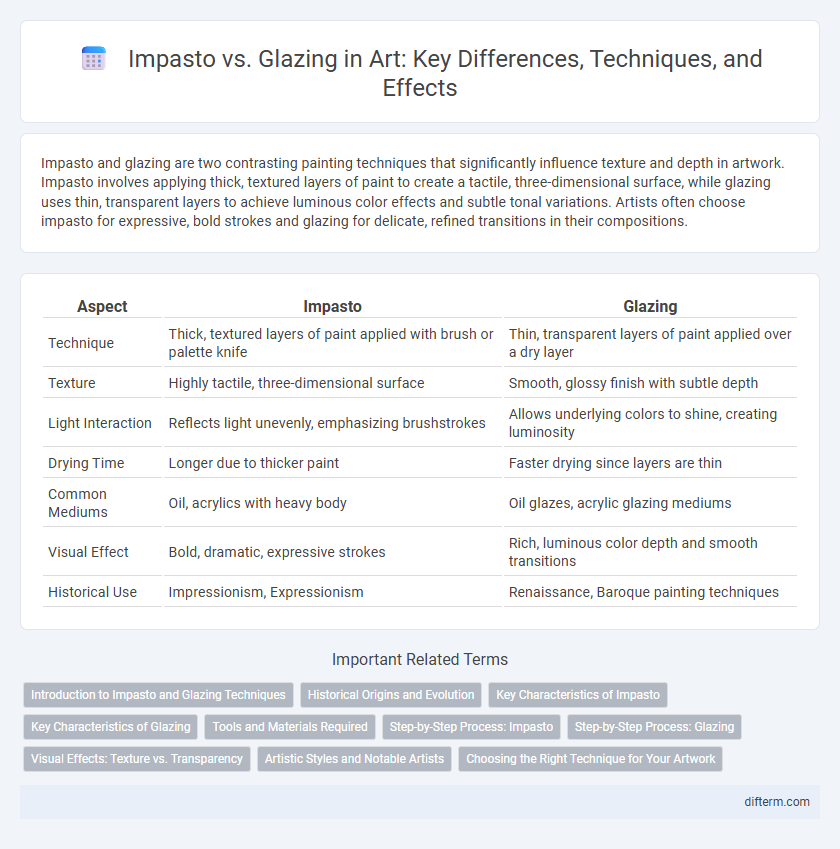Impasto and glazing are two contrasting painting techniques that significantly influence texture and depth in artwork. Impasto involves applying thick, textured layers of paint to create a tactile, three-dimensional surface, while glazing uses thin, transparent layers to achieve luminous color effects and subtle tonal variations. Artists often choose impasto for expressive, bold strokes and glazing for delicate, refined transitions in their compositions.
Table of Comparison
| Aspect | Impasto | Glazing |
|---|---|---|
| Technique | Thick, textured layers of paint applied with brush or palette knife | Thin, transparent layers of paint applied over a dry layer |
| Texture | Highly tactile, three-dimensional surface | Smooth, glossy finish with subtle depth |
| Light Interaction | Reflects light unevenly, emphasizing brushstrokes | Allows underlying colors to shine, creating luminosity |
| Drying Time | Longer due to thicker paint | Faster drying since layers are thin |
| Common Mediums | Oil, acrylics with heavy body | Oil glazes, acrylic glazing mediums |
| Visual Effect | Bold, dramatic, expressive strokes | Rich, luminous color depth and smooth transitions |
| Historical Use | Impressionism, Expressionism | Renaissance, Baroque painting techniques |
Introduction to Impasto and Glazing Techniques
Impasto technique involves applying thick layers of paint to create texture and depth, highlighting brushstrokes or palette knife marks that enhance the three-dimensional effect on canvas. Glazing, in contrast, uses multiple thin, transparent paint layers to build luminous color and subtle tonal variations, creating depth through light reflection rather than texture. Both techniques serve distinct artistic purposes, with impasto emphasizing tactile surface quality and glazing focusing on optical richness and color complexity.
Historical Origins and Evolution
Impasto, characterized by thick, textured brushstrokes, originated in the Renaissance and flourished during the Baroque period as artists like Rembrandt used it to enhance light and depth in paintings. Glazing, involving thin translucent layers of paint, evolved in the Northern Renaissance with artists such as Jan van Eyck, who perfected the technique to achieve luminous color effects and subtle details. Both techniques transformed artistic expression by offering contrasting methods for manipulating texture, light, and color throughout art history.
Key Characteristics of Impasto
Impasto is a painting technique characterized by thick layers of paint applied to create texture and depth, often resulting in visible brush or palette knife strokes. This method enhances the three-dimensional quality of artwork, allowing light to interact with raised surfaces for dynamic visual effects. Impasto is commonly used in oil and acrylic paintings to emphasize emotion and movement through tactile, expressive surfaces.
Key Characteristics of Glazing
Glazing involves applying thin, transparent layers of paint to create depth and luminosity, allowing underlying colors to shine through with subtle shifts in tone. This technique emphasizes smooth, glass-like surfaces and enhances the richness of color by building multiple translucent layers. Artists often use glazing to achieve delicate light effects, refine details, and create a polished, glowing finish in their paintings.
Tools and Materials Required
Impasto techniques require thick oil or acrylic paints, palette knives, and stiff brushes to create textured, three-dimensional surfaces on canvas. Glazing relies on transparent or semi-transparent layers of oil or acrylic paint, applied with soft brushes or glazing brushes to achieve depth and luminosity. Both methods benefit from primed surfaces like canvas or wooden panels to ensure proper adhesion and longevity.
Step-by-Step Process: Impasto
Impasto involves applying thick layers of paint with a palette knife or brush to create textured, three-dimensional surfaces that capture light and shadow. Artists typically start by sketching the composition, then build up the paint in heavy strokes, allowing each layer to dry partially before adding more depth and highlights. This technique emphasizes bold, expressive strokes and a tactile surface that enhances the emotional intensity of the artwork.
Step-by-Step Process: Glazing
Glazing in art involves applying multiple thin, transparent layers of paint over a dried base layer to achieve depth and luminosity. Each glaze must dry completely before the next is applied, allowing light to penetrate and reflect off underlying colors, enhancing richness and subtlety. This meticulous layering technique contrasts with impasto's thick texture, emphasizing controlled transparency for nuanced color effects.
Visual Effects: Texture vs. Transparency
Impasto techniques create bold, textured surfaces by applying thick layers of paint, enhancing the painting's dimensionality and tactile quality. In contrast, glazing involves applying multiple thin, transparent layers that build depth and luminous color effects without altering the texture of the canvas. The visual impact of impasto emphasizes physicality and light reflection on raised paint, while glazing produces subtle tonal variations and a glowing translucency.
Artistic Styles and Notable Artists
Impasto is characterized by thick, textured layers of paint that create a three-dimensional effect, famously used by artists like Vincent van Gogh and Jackson Pollock to convey emotion and movement. In contrast, glazing involves applying thin, transparent layers of paint to build depth and luminosity, a technique masterfully employed by Renaissance painters such as Leonardo da Vinci and Jan van Eyck. These distinct artistic styles highlight different approaches to texture and light, influencing the visual impact and emotional resonance of a painting.
Choosing the Right Technique for Your Artwork
Impasto creates texture and depth by applying thick layers of paint that catch light and add dimensionality, ideal for expressing emotion and movement in artwork. Glazing uses thin, transparent layers to build luminosity and subtle color shifts, perfect for achieving realistic effects and enhancing light within a painting. Choosing between impasto and glazing depends on the desired visual impact, the subject matter, and the artist's technique preference to best convey mood and detail.
Impasto vs Glazing Infographic

 difterm.com
difterm.com